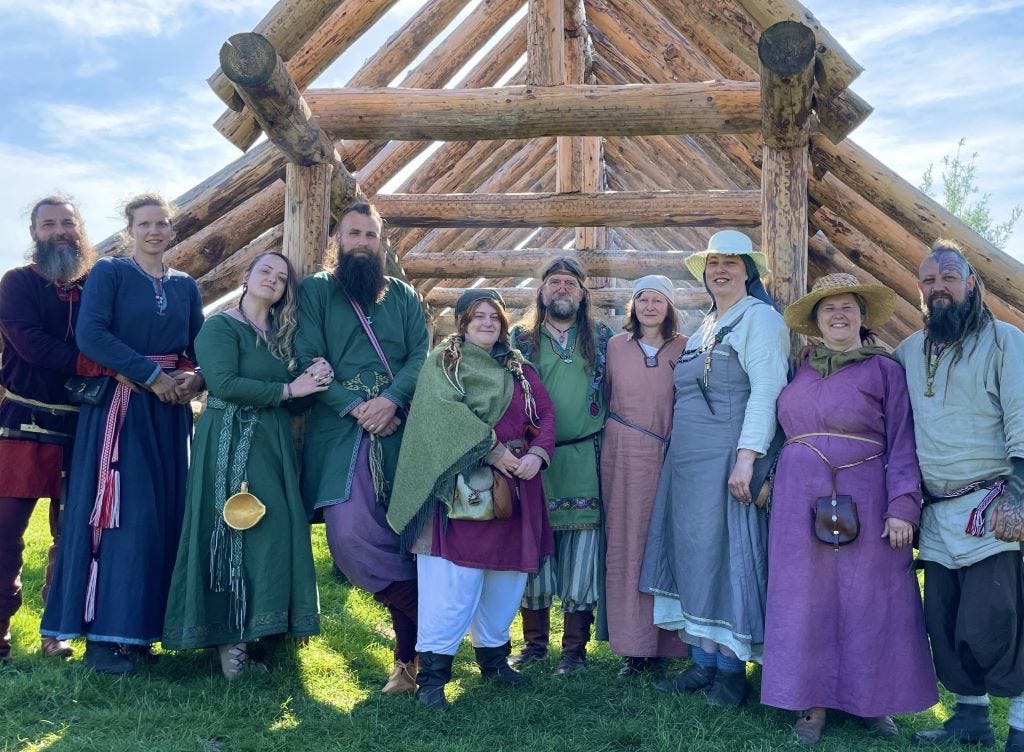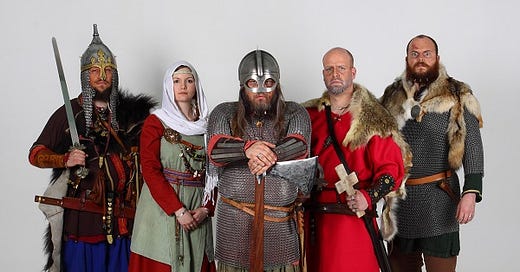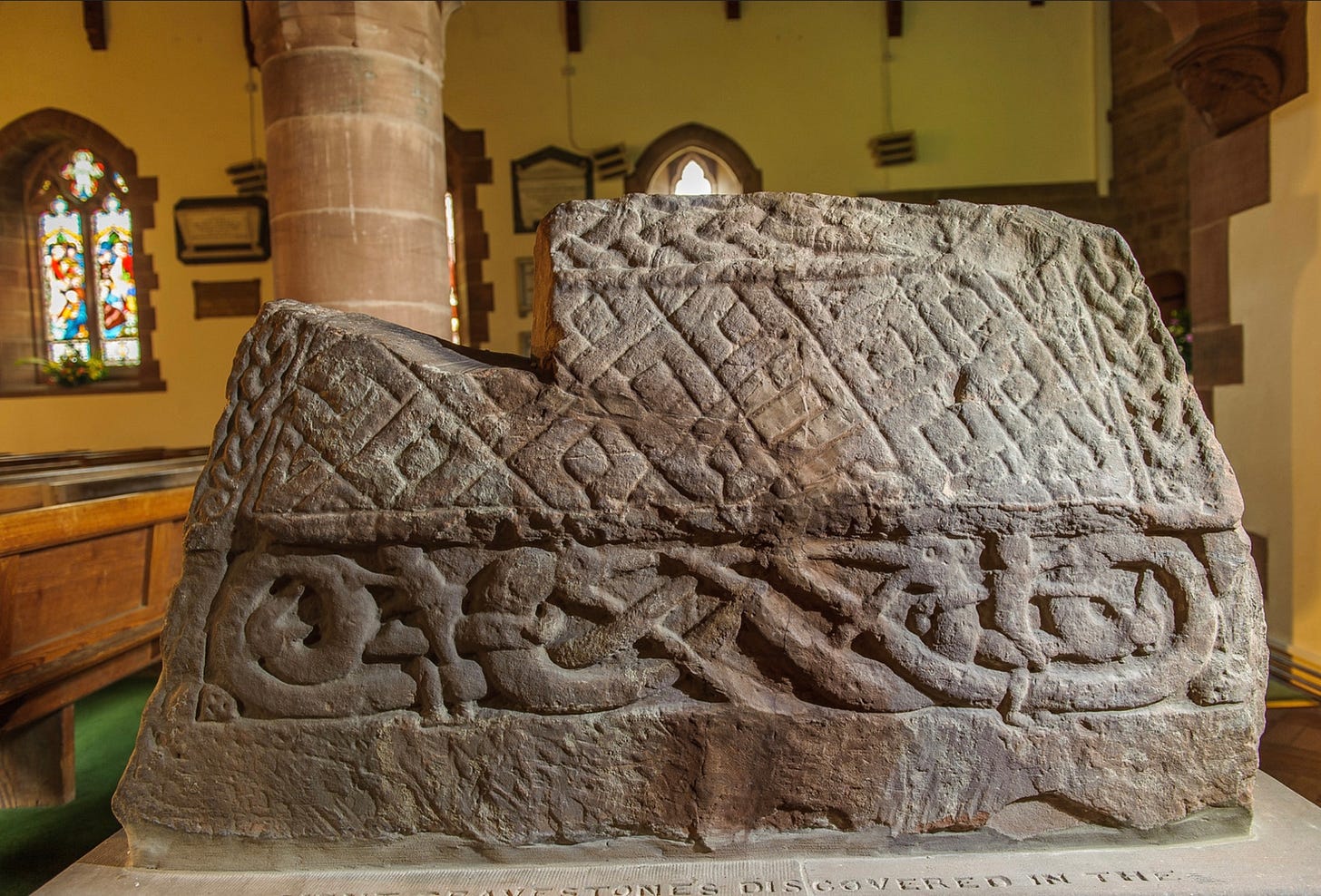Is the Viking invasion of Cumbria a delusion?
Victorians believed Norse warriors landed in the north west a thousand years ago in overwhelming numbers. But new research suggests influx may have involved little more than 1,000 people.
Many experts have said Cumbrians are the descendants of Vikings who invaded a thousand years ago. But is this true?
Victorian antiquarians were fascinated by stone artefacts found on the west coast because they were carved with non-Christian imagery. They decided the sculptures were created by Viking warriors who migrated to Cumbria after a 902 AD war in Ireland.
Over the centuries, these incomers are supposed to have interbred with the local people, greatly influencing Cumbria’s language, agriculture and culture. Some people have argued the English gained the toughness to build an empire because they inherited pure Nordic blood.
The man who fixed the idea of an overwhelming Viking invasion in the general public’s mind was National Trust founder and vicar, Canon Hardwicke Rawnsley of Crosthwaite in Keswick. He declared in 1911 that the Cumberland people belonged to the "square-jawed Viking race.”
He attributed traits such as independence, honour, and a love of adventure to their supposed Norse heritage. He also remarked on their physical features, including blue eyes, as evidence of Viking ancestry.
Though Rawnsley provided anecdotes, not evidence, his statement strengthened the belief that the Norse invaded in such numbers that they sidelined the original Celts and they became the dominant ethnic group.
In other words, nineteenth century intellectuals made the assumption that the discovery of the stonework with the Norse carvings must mean there had been a major invasion of Vikings into Cumbria – and that their presence transformed the nature of the people in ways that explained why the British had come to rule the world. They had created a story that they wanted to hear.

As Andrew Wawn, Leeds University Professor of Anglo-Icelandic Literature said: “In many ways, the Victorians invented the Vikings”. Indeed the word Viking was unknown, according to the Oxford English Dictionary, until 1807. Before then, few suggested that there had been a major Scandinavian assault on Cumbria.
“If the Victorians invented the Vikings, they were responsible for a good deal of nonsense, some of it dangerous nonsense,” Wrote Tom Shippey, Professor of Old English at Oxford University.
Despite that and other condemnations of nineteenth century racial theorising, serious academics still believe there was a significant invasion. Historian Frederick T. Wainwright argued in 1975 that the Norse people carried out a “mass migration” of the north. Others, like Viking scholar Peter Sawyer who died in 2018 backed the idea of a Norse influx, but argued that it was takeover of existing communities by small groups of Irish-Norse elites.
Proponents of the mass invasion theory can point to the 116 pieces of Viking stone sculpture have turned up on 38 sites across the county. They include the renowned Gosforth Cross, a slender 14 foot sandstone shaft smothered with Norse-themed mythological carvings and the so-called Giants Grave which consists of two Scandinavian pillar-crosses and four hogback tomb covers outside St Andrew’s church in Penrith. A collection of Scandinavian sculptures and metalwork was also found under St Michael’s church in Workington.
.The popular media is in no doubt that the Vikings arrived in force. In 2015 the Westmorland Gazette declared: “Archaeological evidence suggests many Norwegian Vikings came from Ireland and the Isle of Man to settle along the west coast of Cumbria.” The English Monarchs website adds: “Successive waves of…Viking peoples…arrived around the south west of Cumbria and gradually penetrated into the uplands of the central region.”
The cache of Norse carvings is certainly impressive. Experts say they were probably created by a small group Norwegian craftsmen who were deeply imbued with Norse culture and iconography. But there is nothing about the carvings that implies they were generated by a large population of incomers.
So, is there any evidence, beyond the stonework, that might prove there was an overwhelming invasion? Yes, there is. Robert Ferguson, a Victorian scholar and antiquarian, wrote a book called The Northmen in Cumberland and Westmoreland (1856), arguing Scandinavian settlers had a major impact on the region’s place names, culture, and history. For example, Ferguson examined Norse etymology in local place names, such as Buttermere, which he attributes to the Old Norse personal name “Buthar.”
His view is still influential today. For example, the former conservative Minister and Penrith MP Rory Stewart in 2015 backed the idea of an overwhelming invasion, writing in his blog that the Vikings: “came to Cumbria in enough force to obliterate almost all the earlier place-names and replace them with their own Norse names.”
But in recent years archaeologists and geneticists have started to question these long-held assumptions. The key problem is that no evidence has yet been found that Vikings actually lived in Cumbria. As Manchester University Archaeology professor Nick Higham wrote: “No proven example of a Scandinavian settlement has yet been located in north Cumbria, despite the massive legacy of place-names.”
In fact, doubts that the number of Viking place names is quite as large as presumed were first raised a long time ago. Antiquarian W G Collingwood, the archaeologist and fine arts professor who established Viking studies as an academic discipline, became unsure towards the end of his life in 1932 about whether the academics studying place names had sufficient expertise in ancient languages. He increasingly feared that ignorance of Celtic and Anglo-Saxon among researchers had led to the number of Viking migrants being wildly overestimated.
This, and the lack of evidence for Viking buildings, the flimsiness of racial theories and the absence in Cumbria of a Scandinavian culture along the lines of Iceland’s Norse Sagas means the question must be asked: was the idea of a Viking invasion of Cumbria a romantic illusion or even a deliberate deception? If it is not outright fiction, how much of the story is real? This piece is aimed at finding that out.
Archaeologist Richard Watson of Manchester University has delivered a health warning about the reliability of the available data, declaring: “It has become virtually a truism that a mass immigration of Vikings occurred to the north-west of England in the tenth century, bringing with it an expansion of settlement into previously little-used and marginal environments.”
But he said that vision is based upon people looking at the distribution of place-names that we can see in the 21st century. It also rests on assumptions about whether the Vikings could have farmed the soil in certain places that we can see today. He said looking for clues in the contemporary landscape was “probably inappropriate” because “it does not necessarily reflect the tenth-century situation.”
He was also concerned that place names were not being “derived from unambiguously Viking-Age evidence.” Many scholars rely on the records on places with Norse names recorded in the Domesday book published in 1086. But it was important to remember that Domesday was compiled by Norman clerks 180 years after the Vikings arrived. In addition, only five place names in the whole of Cumbria can be securely dated beyond doubt to the tenth century because texts written at the time refer to them. Many of the supposedly Norse place names were actually coined in the 12th century, he said.
The Oxford medieval historian Eric Christiansen also cautioned that the previous academic habit of assuming a Norse place name automatically meant Norse people lived there had been disproven. “As Scandinavian place-names can no longer be treated simply as guides to immigration, the maps equating one with the other must now be rolled up,” he declared. “The Vikings grow less tangible the closer the evidence is examined,” though he conceded: “The Viking age sculpture remains the only solid and rewarding evidence.”
A Norse place name does not necessarily indicate that Norse people were in residence. Vikings often named places they visited or influenced, even if they did not settle permanently. For example, they adapted local names into Old Norse or applied descriptive terms based on geography or features, such as “-ness” (promontory) or “-by” (farmstead) . Additionally, Norse names could reflect trading routes, temporary camps, or areas under their control rather than permanent habitation.
Scientific investigations also raise questions about the size of the Norwegian Viking intervention. In 2001, researchers at University College London conducted DNA tests on 2,000 people across England. Of all the English test sites, only Penrith in Cumbria had significant evidence of Norwegian influence. In general, they found that English people had 3-4 percent Norwegian Viking DNA in their makeup. This does not mean our Viking heritage is negligible, but it does illustrate the need to keep the issue in proportion.
Keeping these caveats in mind, Manchester University scholar Linda Corrigan compiled a study which aimed at identifying pre-1100 place names in South Cumbria, covering all of Westmorland; the North Lonsdale ward of Lancashire, and the Copeland area of Cumberland. She chose that target date because there are no records of Viking incursions into Cumbria after that time.
She found seventy-five place names in the study area that could plausibly date from before 1100 of which the largest single group (thirty-three) were old english compared to just fourteen old norse. She then looked for personal names which might indicate the ethnic identity of whoever named the place in question.
Again, there are many more old english personal names (eight) than old norse (two) and there is only one gaelic (Irish), the saint’s name Sanctán. Just less than half the names (thirty) refer to landscape features such as saetr the Norse word meaning mountain pasture and hafrebek meaning the slope where the oats grow. Of these, twenty-two come from words that mean the same in both old English and old Norse. The old Norse landscape words appear mainly in South Westmorland with just one in Copeland.
Linda Corrigan concluded: “This perhaps implies a heavier Scandinavian naming presence in South Westmorland than elsewhere, but still not a dominant presence. The overall picture is therefore very heavily Old English.”
She went on: “These conclusions leave us with some questions, first among which must be where were the Scandinavians in Anglo-Saxon South Cumbria?” She added that she had named her survey ‘Hunting the Vikings from Ambleside to Haverbrack’, because it really was a case of hunting for them, for Scandinavian elements are not as prevalent as might have been expected.”
She had no doubt there were some Vikings around because there were fine Norse carvings such as the Gosforth Cross “ but their numbers and impact on place-naming must be questioned,” she added.
This result deals a severe blow to the long-held view that there was an overwhelming Viking invasion. It “counts against suggestions that the area was overtaken by Scandinavians,” she wrote.
Linda Corrigan concluded that there was a “possibility that there were two separate communities, speaking different languages and naming places separately.”
So, if the evidence now suggests that the number of Vikings was small, is there any we can work out how small?
One approach has been suggested by Geoffrey M Hodgson, Emeritus Professor at the London campus of Loughborough University. He analysed Cumbrian marriage records to work out the rate of family formation. Then he scaled the figures back to take account of the fact that in the 10th century the population of England was just one million.
“From this we can gauge the relative sizes of the Irish-Norse settlements in Cumbria and Lonsdale in Lancashire. They amounted to between one and two thousand Vikings,” Geoffrey Hodgson wrote. At this time the total population of Cumbria is estimated to have been about 10,000 people.
This is an extract from a forthcoming book. There are already five books in the series of Hidden Cumbrian Histories. You can buy them at The New Bookshop, Main Street, Cockermouth, Bookends in Keswick and Carlisle, along with Sam Read in Grasmere.
Buy online here: www.fletcherchristianbooks.com
TO READ THE WHOLE ARTICLE AND MORE, SIGN UP TO A PAID SUBSCRIPTION
Keep reading with a 7-day free trial
Subscribe to Hidden Cumbrian Histories to keep reading this post and get 7 days of free access to the full post archives.





